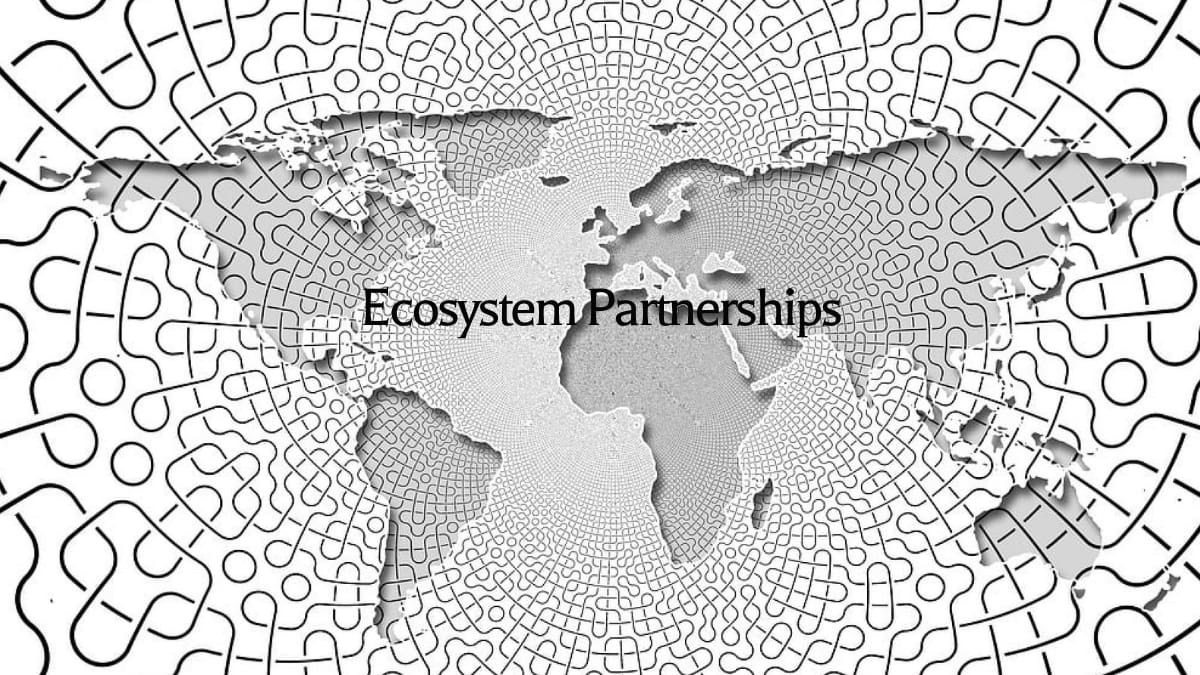Table of Contents
In today’s ever-evolving business landscape, entrepreneurs are constantly seeking innovative strategies to drive growth and stay ahead of the competition. One such strategy that has gained significant traction in recent years is ecosystem partnerships. This approach involves collaborating with other companies, organizations, and stakeholders to create a mutually beneficial network that fosters innovation, drives value, and expands market reach.
“Coming together is a beginning; keeping together is progress; working together is success.” – Henry Ford
So, what exactly are ecosystem partnerships, and why are they essential for entrepreneurs? Let’s break it down in simple terms.
Understanding Ecosystem Partnerships
Imagine your business as a single tree in a vast forest. While the tree can thrive on its own, it becomes even more robust when it’s part of a thriving ecosystem. Ecosystem partnerships work on a similar principle. Rather than operating in isolation, entrepreneurs form strategic alliances with complementary businesses, suppliers, customers, and even competitors to create a cohesive ecosystem.
These partnerships are not limited to traditional business relationships. They can extend to academic institutions, research organizations, government agencies, and technology providers. The goal is to leverage the strengths and resources of each partner to achieve common objectives and drive collective success.
The Benefits of Ecosystem Partnerships
Access to Resources: One of the most significant benefits of ecosystem partnerships is the access to a diverse range of resources. When entrepreneurs collaborate with partners, they can tap into the expertise, technology, capital, and distribution channels that these partners bring to the table. This shared access is particularly valuable for startups, which often face resource constraints. Instead of making substantial upfront investments, startups can leverage the resources of their partners to overcome these limitations and accelerate their growth. For example, a tech startup might partner with a larger firm to access advanced technology or a manufacturing network, thereby avoiding the high costs and time delays associated with developing these capabilities in-house.
Innovation Catalyst: Ecosystem partnerships act as a catalyst for innovation by combining different perspectives, skills, and capabilities from various partners. This collaborative environment encourages the exchange of ideas and fosters creativity, enabling entrepreneurs to co-create new products, services, and business models. By addressing unmet customer needs and exploring new market opportunities, these partnerships can lead to market disruption and provide a competitive edge. For instance, a healthcare startup might partner with academic institutions and tech companies to develop cutting-edge medical devices or software, resulting in innovative solutions that might not have been possible independently.
Market Expansion: Through ecosystem partnerships, entrepreneurs can tap into new markets and customer segments more effectively. By partnering with complementary businesses, startups can leverage their partners’ existing customer bases and distribution networks. This approach allows for rapid scaling and geographical expansion with minimal friction. For example, a local food producer might partner with an international distributor, enabling the producer to reach global markets and increase sales without the logistical challenges of setting up an international distribution network from scratch.
Risk Mitigation: Startups often operate in volatile environments characterized by market fluctuations, regulatory changes, and technological disruptions. Ecosystem partnerships can help mitigate these risks by distributing them across multiple stakeholders. By diversifying revenue streams and sharing the burden of potential challenges, these partnerships provide a buffer against adverse conditions. For instance, a startup reliant on a single market might partner with firms in different industries or regions, reducing its vulnerability to market-specific downturns and enhancing its overall stability.
Enhanced Credibility: Collaborating with established industry players significantly boosts the credibility and reputation of startups. When a startup associates with trusted and well-known brands, it gains immediate legitimacy in the eyes of customers, investors, and other stakeholders. This enhanced credibility can lead to increased trust and faster market acceptance. For example, a new fintech company might partner with a leading bank, leveraging the bank’s reputation to build customer confidence and attract investment more readily than it could on its own.
Key Considerations for Building Ecosystem Partnerships
While the benefits of ecosystem partnerships are undeniable, building and maintaining successful alliances require careful planning and execution. Entrepreneurs must be strategic and thoughtful to ensure these collaborations achieve their intended outcomes.
Strategic Alignment: The foundation of a successful ecosystem partnership lies in selecting partners whose goals, values, and strategic priorities align with yours. It’s essential to look beyond immediate business needs and consider the long-term vision and mission of potential partners. By choosing entities that share similar objectives and ethical standards, you can foster a partnership where each party is genuinely committed to mutual success. Additionally, identify complementary strengths and capabilities that can enhance the value proposition for both parties. This synergy ensures that the partnership creates greater value collectively than each organization could achieve independently.
Clear Communication: Effective communication is critical for the success of any partnership. From the outset, establish clear expectations, roles, and responsibilities. This transparency helps avoid misunderstandings and conflicts that can derail collaboration efforts. It’s important to have regular and open channels of communication where partners can discuss progress, challenges, and future plans. By maintaining consistent and honest communication, trust is built, which is the bedrock of any strong partnership. Furthermore, having formal agreements and documented plans can provide a reference point for resolving any disputes that might arise.
Mutual Benefit: For a partnership to be sustainable, it must deliver value to all stakeholders involved. It’s crucial to seek win-win opportunities where each partner gains tangible benefits that justify their investment of time, resources, and expertise. This means understanding the needs and objectives of your partners and finding ways to address them while also advancing your own goals. By ensuring that the partnership is mutually beneficial, you create a balanced relationship where all parties are motivated to contribute their best efforts and resources.
Flexibility and Adaptability: The business environment is dynamic, and successful ecosystem partnerships require a willingness to embrace change. Be open to adapting your strategy and approach as the partnership evolves and market conditions change. Flexibility allows the partnership to respond to new opportunities and challenges effectively. This might involve revisiting and revising initial agreements, exploring new areas of collaboration, or even changing the nature of the partnership as necessary. By being adaptable, you ensure that the partnership remains relevant and beneficial over time.
Continuous Evaluation: Regular assessment of the partnership’s performance is essential to ensure it remains on track and continues to deliver value. Establish predefined metrics and key performance indicators (KPIs) to monitor progress. These evaluations should be conducted periodically to identify areas for improvement and to address any challenges or bottlenecks that may arise. Continuous evaluation provides an opportunity to celebrate successes, learn from failures, and make informed decisions about the future direction of the partnership. It also demonstrates a commitment to excellence and accountability, which can further strengthen the relationship between partners.
Real-World Examples
Numerous successful companies have leveraged ecosystem partnerships to fuel their growth and innovation. For example:

Reliance Jio: Reliance Jio, a telecommunications giant in India, has successfully built an ecosystem that spans multiple sectors, including digital services, e-commerce, entertainment, and financial services. Jio’s ecosystem includes partnerships with content providers, app developers, device manufacturers, and retail businesses. For instance, Jio collaborates with global technology companies like Google and Facebook to enhance its digital services and bring innovative solutions to the Indian market. The company also partners with content creators to offer a wide range of entertainment options through platforms like JioTV and JioSaavn. By creating a comprehensive ecosystem that integrates telecommunications with various digital services, Jio has revolutionized the Indian telecom industry and expanded its market reach.
Apple: Through its App Store ecosystem, Apple has created a thriving marketplace where developers, content creators, and users come together to access and share digital content and services. This ecosystem allows developers to create and distribute apps that enhance the functionality of Apple devices, thereby increasing their appeal to consumers. Content creators, such as musicians and filmmakers, can distribute their works through platforms like Apple Music and Apple TV+, reaching a global audience. Users benefit from a wide range of high-quality apps and content that enhance their experience with Apple products. This interdependent network of developers, creators, and users not only drives innovation but also generates significant revenue for Apple, reinforcing its position as a leader in the technology sector.
Infosys: Infosys, one of India’s leading IT services companies, has built an extensive ecosystem partnership strategy to drive its growth and innovation. The company collaborates with global technology leaders, startups, academic institutions, and industry consortia to co-create solutions that address complex business challenges. For example, Infosys partners with tech giants like Microsoft, SAP, and IBM to deliver integrated services and solutions to clients worldwide. Through its Innovation Network (IIN), Infosys engages with startups to explore emerging technologies and new business models. Additionally, the company collaborates with academic institutions to advance research in areas such as artificial intelligence, blockchain, and cybersecurity. These partnerships enable Infosys to stay at the forefront of technological innovation and deliver cutting-edge solutions to its clients.
Google: Google’s ecosystem includes partners from various industries, including hardware manufacturers, software developers, advertisers, and content creators, who collaborate to enhance the user experience across its products and services. For instance, the Android operating system powers a multitude of devices from different manufacturers, creating a unified platform that benefits from Google’s extensive app ecosystem. Advertisers leverage Google’s search engine and YouTube platform to reach targeted audiences, while content creators use these platforms to distribute their work and engage with viewers. By fostering an open and collaborative environment, Google continuously innovates and improves its offerings, maintaining its dominance in search, advertising, and mobile operating systems.
Conclusion
In today’s interconnected world, ecosystem partnerships have emerged as a powerful business strategy for entrepreneurs looking to drive growth, innovation, and market expansion. By collaborating with complementary businesses and stakeholders, startups can access valuable resources, foster innovation, mitigate risks, and enhance their credibility in the marketplace.
However, building successful ecosystem partnerships requires careful planning, strategic alignment, clear communication, and a willingness to adapt to changing market dynamics. By following these principles and learning from real-world examples, entrepreneurs can harness the full potential of ecosystem partnerships to achieve sustainable competitive advantage and long-term success in their respective industries.















